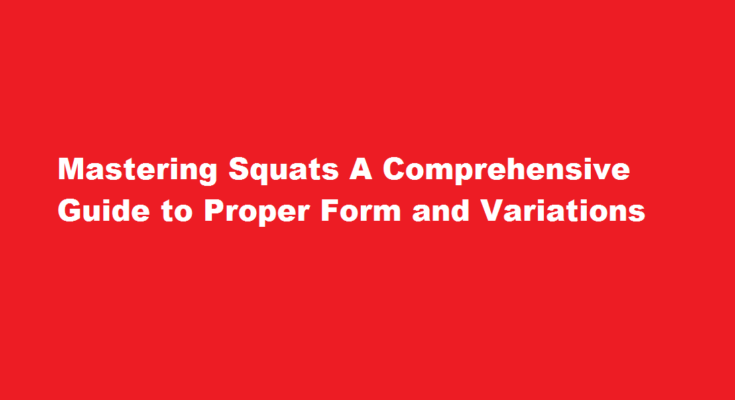Introduction
Squats are one of the most effective and versatile exercises that can significantly benefit your overall fitness and strength. From athletes to fitness enthusiasts, incorporating squats into your routine can yield remarkable results. However, to fully reap the benefits, it is essential to perform squats with proper form to avoid injuries and maximize the gains. In this comprehensive guide, we will delve into the mechanics of squats, step-by-step instructions for proper execution, common mistakes to avoid, and various squat variations to challenge yourself.
Understanding the Mechanics of Squats
Squats are compound exercises that engage multiple muscle groups simultaneously, including the quadriceps, hamstrings, glutes, core, and lower back. They also promote better balance and flexibility, making them a fundamental movement pattern for everyday activities.
To execute a squat correctly, stand with your feet shoulder-width apart and toes pointing slightly outward. Lower your body by bending at the hips and knees, as if you are sitting back into an imaginary chair. Keep your chest up, back straight, and maintain a neutral spine throughout the movement. Descend until your thighs are parallel to the ground or slightly below, and then push through your heels to return to the starting position.
Step-by-Step Guide to Proper Squat Form
- Set Up Stand with your feet shoulder-width apart or slightly wider, toes turned out at a comfortable angle.
- Engage Core Tighten your core muscles to stabilize your spine throughout the movement.
- Descend Initiate the squat by pushing your hips back and bending your knees. Keep your chest up and look straight ahead to maintain a neutral neck position.
- Depth Lower your body until your thighs are parallel to the ground or just below, ensuring your knees are in line with your toes.
- Push through Heels Drive through your heels to return to the starting position, fully extending your hips and knees.
- Breathing Inhale as you lower down, and exhale as you rise back up.
Common Mistakes and How to Avoid Them
- Knee Overextension Avoid allowing your knees to extend beyond your toes during the squat. This puts unnecessary strain on the knees and increases the risk of injury. Instead, focus on pushing your hips back and keeping your knees in line with your toes.
- Rounded Back Maintaining a rounded back during squats can lead to spinal injuries. Keep your back straight and chest up throughout the movement.
- Not Going Deep Enough Failing to reach adequate depth reduces the effectiveness of squats. Strive to achieve at least parallel thighs to maximize muscle engagement.
- Arching Lower Back Overarching your lower back can cause lower back pain. Keep your core engaged and maintain a neutral spine.
Squat Variations to Spice Up Your Workout Routine
- Goblet Squats Hold a dumbbell or kettlebell close to your chest as you squat. This variation emphasizes form and balance.
- Sumo Squats Stand with your feet wider than shoulder-width apart and toes pointing outward. This targets the inner thighs and glutes.
- Pistol Squats Challenge your stability and strength by performing squats on one leg. Use a support or hold your opposite foot in front for balance.
- Jump Squats Incorporate plyometrics by exploding off the ground during the ascent. Land softly and descend into the next squat immediately.
Frequently Asked Questions
What is the principle of squat?
Unlike the deadlift, the squat is a knee-dominant movement. You sit back by bending your knees – allowing them to track forward – and then extending them to get back to a standing position. Your hips bend and extend as well, which effectively trains your glutes. It’s almost as if you were sitting down on a chair.
Which muscles are used in squats?
Squats are a compound exercise. This means that they activate a variety of lower body muscle groups. The groups worked are the glutes, hips, quads, hamstrings, and calves.
Conclusion
Squats are a powerhouse exercise that provides numerous benefits for your overall fitness. By understanding the mechanics and mastering proper form, you can prevent injuries and achieve optimal results. Don’t forget to challenge yourself with various squat variations to keep your workouts engaging and effective. As with any exercise, listen to your body, start with manageable weights, and gradually increase intensity as you become more confident in your abilities. Happy squatting!
Read Also : Mastering VLOOKUP in Excel A Comprehensive Guide



